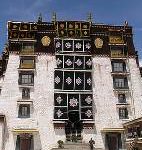The summer had only just started, but village elder Yuzhen was already looking forward to winter. Standing in front of her home in Tingri, Tibet, one looks up and sees the snowy peak of Mount Everest, also known as Qomolangma. The house is only 40 kilometres from Everest Base Camp.
Winter used to be a lengthy ordeal for the villagers. High altitudes and thin air mean that the local climate is icy. Indoor temperatures at night drop below zero. “It is as cold inside as it is out,” said Yuzhen.
However, Yuzhen’s new solar home uses the ample Tibetan sunlight to reduce the reliance on dung for heating. “These solar homes not only improve the standard of living, but also help to protect the Everest region’s vulnerable ecology,” said Zeng Yan, the architect of the house, who is also chief architect at the Solar Buildings Insitute of the China National Engineering Research Center. “If this demonstration is successful, they will be used more widely.”
Tibet has the strongest and most frequent sunlight of any region in China. In an average year it enjoys over 3,000 hours of sunshine. However, residents need heating from mid-July onwards. A lack of natural resources means they rely on dung, wood and turf for fuel.
Yuzhen, like the other residents, spends a large part of her day gathering and drying dung before moving it indoors. Sometimes she will walk up the mountainside to collect firewood or turf, but ecological damage in recent years has meant that firewood was not being replenished and grass was not growing where turf had been removed.
Therefore, a typical household burns 300 bags of dung a year, totalling around 2,000 kilograms. Half of that needs to be bought. But dung is not an efficient fuel. “It only gives limited warmth,” said Zeng. “It also fills the room with smoke.” Coal is not mined in Tibet. Oil and natural gas are scarce: fuel is imported via a 1,000-kilometre pipeline from Golmud to Lhasa, but it is very expensive by the time it has been transported another 700 kilometres to the Everest region.
Therefore, the area become part of the “Mt. Everest Action at the Third Pole of the Earth” environmental protection programme, which has already provided funding to the world’s highest school and brought electricity to the world’s highest village.
In early 2009 the project completed a model of a “plateau ecological energy-saving building”, with the support of the China National Engineering Research Center for Human Settlements, the Department of Building Science at Tsinghua University and the Tibetan Science and Technology Association. Construction on the house started in April.
According to the project chief, Yang Yan, both wind and methane were initially considered as energy sources. However, both of these options had their limitations. “Wind power is limited by the direction of the wind, while methane is only flammable in a warm environment.”
On June 5, builders and volunteers installed the final piece of heat storage material, meaning that construction had been completed. “The three core technologies are insulation, heat gathering and heat storage,” said Zeng. The high costs of photovoltaic solar power meant that passive solar energy was used.
The designers examined the insulation in traditional Tibetan buildings, identifying weaknesses and making some improvements. In early studies, they found that traditional buildings provided insulation through the use of thick walls, but windows and doors allowed drafts to enter. Also, a simple weight-bearing structure meant that the roofs allowed in drafts.
Therefore, Zeng thickened the roof and carefully designed windows and doors that let in more light and improved insulation. The walls and the roof of the building include a house wrap membrane which keeps water out, but allows air to circulate. This adds no weight to the structure, but improves water and draft-proofing and provides better insulation. “It’s like a raincoat for your house,” said Zeng.
A glass hothouse was built on the sun-facing side of the building. The sun’s heat is trapped there, where it can be transferred to the rest of the house simply by opening internal doors and windows. The south-side of the building also features a heat collector, which uses the sun’s rays to warm air that is fed into the house. There are also two heat-gathering paved beds that store and slowly release heat. Large skylights in the roof heat the house and improve indoor lighting.
“Our tests show that annual dung usage will be cut in half. Indoor night-time temperatures during winter will be around 10 degrees Celsius, rather than the current zero degrees,” said Zeng.
In remote Tibetan areas, houses are normally built with whatever materials lie to hand. Little cost is incurred. The walls are usually concrete, stone or mud bricks, in descending order of cost. Concrete buildings are not eroded by the rain and are thus popular in more affluent villages. However, mud bricks have always been the most common building material, which farmers and herders can easily make at home.
Three “local principles” were identified at the start of the design process: retaining local building traditions, using local materials and using local labour. Therefore, the new building primarily uses mud bricks, rather than concrete. “We chose to combine a small quantity of key environmentally friendly functional materials with locally available materials,” said Zeng.
Even so, the locals would not be able to afford to build a house like this. A typical Tibetan villager earns an annual wage of 1,700 yuan (US$249). One of these homes costs around 60,000 yuan (US$8,779).
However, The Tibet Autonomous Region is attempting to reduce the costs of building homes for farmers and herders with subsidies of 10,000 to 25,000 yuan (US$1463 to $3658), along with discounted interest rates, preferential allocation of aid funds, loan support and funding from local government. Yang Yan said that the completion of Yuzhen’s home would be followed with efforts to encourage the wider use of these building designs, particularly in remote areas.
Cai Rupeng is a reporter for China Newsweek. This article first appeared in China Newsweek; it is used here with permission.
Homepage image by reurinkjan


